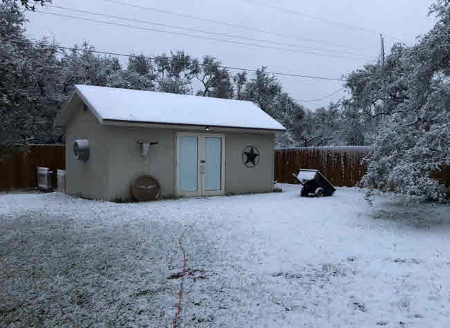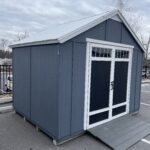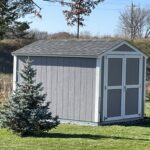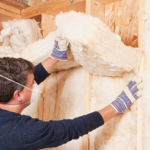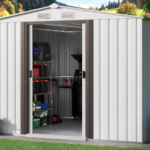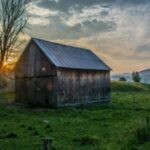Tips to Help You Winterize Your Storage Shed
Having any kind of outbuilding requires maintenance, but if you are in a climate that experiences real winter, taking a few extra steps to winterize your shed or barn can make a huge difference in the structure’s longevity. To make it through winter with the least complications, you must plan ahead and prepare while the weather is still pleasant. “Plan for the worst and hope for the best” is a motto we should all have when protecting our homes and belongings.
Storage shed winterization will be decided by the type of storage shed you have, and the things you are storing in the structure. With just a little planning you can make certain that your belongings are protected through the winter so when the weather gets bad you do not have to worry or rush around trying to fix problems. The last thing you want is to start using the shed again in the spring, only to find that it is worse for the wear due to a harsh winter.
Shed Winterization Steps
The first steps to winterizing your shed require you to inspect the shed for possible problem areas, or for potential problem areas.
Outside the Shed
Inspect The Roof
You need to visually inspect the roof of the shed. If you have a tine roof you are looking for loose metal, signs of screws backing out, and debris that may be piling up on the roofing material. Sweep away any debris and take the time to do a thorough inspection. With a metal roof, the most common problem is the rubber washers that surround the screw head can be damaged by the outdoor elements. If these rubber washers appear to be damaged you can buy replacement washers, or even screws with larger washers, that you can use instead of the older one.
common problem is the rubber washers that surround the screw head can be damaged by the outdoor elements. If these rubber washers appear to be damaged you can buy replacement washers, or even screws with larger washers, that you can use instead of the older one.
If your shed has shingles on the roof you are going to touch the shingles to see if they have become brittle. Look for curling around the edges or for shingles that may be starting to crack. If you find any of these shingle problems replace the shingles before winter starts.
Inspect the trees around the shed. You want to trim any low limbs that threaten to break and fall onto the shed in an ice or wind storm. Falling limbs can do sever damage to the shed and the things you have stored inside, and those limbs will be much more likely to fall if they get a heavy, wet snowfall on them, adding many pounds to their weight.
Go inside the shed and visibly inspect the roof and ceiling for signs of water damage. Water leaks can damage the stored items in the shed, and can create the perfect environment for mold and mildew to begin growing.
Finally, be sure that the leaves from autumn are off your shed, because they can trap snow or ice and create moisture issues. Depending on the height of the shed, use a leaf blower or a rake or broom. If using a ladder, be safe and don’t take any chances! Falls can occur in an instant.
Clean the Gutters
Some sheds have gutter systems, and some have downspouts. You need to take the time and clean all debris out of your gutters and downspouts. These systems allow the rainfall, and melting snow and ice to fall away from the building. It is imperative that the gutters and downspouts are not clogged with old leaf matter and debris, so the water will not back up come springtime and cause damage to your roofing materials.
Grade Around the Shed to Prepare for Spring Runoff
Nine times out of ten you have not thought about the water damage that comes when the spring temperatures start to melt the ice and snow. If you live in an area that gets a lot of ice and snow there is a chance that when it starts to melt then water will build up under and around your shed. That water can damage the structure, make it slide from its blocks, and damage the flooring and framework. You can have an entirely flooded shed floor.
I once had a shed that experienced a flooded floor every single spring. This was because the shed was built in to a hill, and the spring runoff naturally worked its way into the shed as it all ran downhill. Until I modified the grade and installed a small draintile, the problem persisted every spring.
Before winter starts you can cut the soil surrounding the building down and create a grade that will allow any water from thawing snow or ice to move past your building rather than pooling under or around it. You might be able to do this grade work using a shovel, or you may want to consider renting some digging equipment to help you.
If your grade is OK but you still get a few drops of water every spring, you can always waterproof the shed foundation or floor.
Underpinning
If you do not have underpinning on your shed you may want to consider doing this. Underpinning or skirting are the same thing, and they allow you to create a barrier between the elements and the important equipment under your shed.
you to create a barrier between the elements and the important equipment under your shed.
Underpinning will help protect pipes from freezing, and will deter rodent infestations. Underpinning is usually low in cost and it makes the building look better and stops the cold wind from blowing beneath the floor of the structure.
Inside the Shed
Winterizing Your Shed’s Interior to Prevent Water Damage
Some storage sheds have running water and electricity connected to them. One of the main considerations that winter brings is freezing water pipes that burst, damage the structure, and damage the contents of the structure.
If you have water going to the shed, in a faucet, shower, toilet, or any other capacity you have to protect the water pipes from freezing.
- Pipe insulation is one of the things that will help you protect your water pipes. Insulate the pipes, and put outdoor faucet covers over the faucets to prevent the faucets from freezing.
- Shut the water off and drain the pipes. If you will not be using the water in the shed during the winter months the best idea for protecting the pipes is to shut the water off to the pipe and drain all existing water that is in the pipes. This will prevent breaks, leaks, and water-related damages.
- If you have a sink, shower, or toilet inside the storage shed you also need to protect the drain lines. You want to use pipe insulation and wrap the lines so they can tolerate freezing temperatures without becoming frozen. Even if your shed won’t freeze, many months of non-use can create musty smells if water is sitting dormant.
Rodent Prevention in your Shed
Oh, those darn rodents. I’ve been into many sheds that immediately smell of mice, because the little critters us the shed as their winter home.
Making a shed rodent resistant is easier said than done. Rodents are looking for warm places to call home and your shed may look like the perfect place for them. Prepare early and you will not have damaged property and exposure to diseases rodents carry when you open the shed back up in the spring.
place for them. Prepare early and you will not have damaged property and exposure to diseases rodents carry when you open the shed back up in the spring.
Rodent prevention requires you to search for any small holes or gaps that the little creatures can come in through. A mouse is flexible and can squeeze into an opening that measures no more the one-fourth of an inch. Inspect the baseboards inside the shed for any gaps, look around windows and doors to make sure that there are no gaps, and check your roof for any possible holes. Use spray foam or stuff materials into any cracks to prevent them from gaining entry.
You can put out rodent poisoning inside the shed, but if they eat the poison, and die in the shed, the odor will be pungent by the time you open the shed back up in the winter.
If you store seeds or things that rodents will find to be a food source make sure they are stored in an airtight container. The airtight container will keep the creatures from smelling the food. I usually find that I need to seal things like birdfood or grass seed in an sealed container in order to keep mice from finding them.
Trim all of the bushes around the shed. Remove wood piles that might be places for rodents to hide close to the shed.
Prepare Heaters for Winter
If you have a heater inside the shed you need to prepare it for the winter. You will want to go through the heater and make certain that it is functioning properly. You don’t want to be doing this job when it is -5 degrees and the heat has become necessity.
functioning properly. You don’t want to be doing this job when it is -5 degrees and the heat has become necessity.
Clean the heater to remove any dust or dirt that may be on the filter or on the heat source. Sweep under the heater to make sure that dust or debris has not gathered beneath it. You want the area around, above, and under the heater to be clean to reduce fire hazards.
If you have a disposable filter, it is a good idea to change it. I like to start each season with a brand new, clean filter.
Organize Everything
Organizing the contents of the shed before winter will give you more room to store items, and it will make it easier for you to move around inside the shed if you have to enter to retrieve an item.
This is the time to do that shed cleaning that you have been putting off.
- Clean away any cobwebs
- Throw away all trash, broken items, or things you cannot remember why you saved
- Put as many things as possible in airtight containers.
- Sweep out all dirt and debris.
Secure Doors and Windows
Make sure that your doors on the shed are closing properly. Look for problems with the threshold, and check for any gaps that will allow wind, weather, or unwanted guests to enter.
Close and lock your windows to the shed. Feel around the window to ascertain if any air can get in or out. Fill in any gaps with caulk, or spray foam.
If you have hard winters with heavy winds or storms consider placing shutters over the windows on the exterior of the building to protect your glass.
Rotate Your Equipment
Last but not least, rotate the stuff inside the shed so you have easy access to winter items, and that summer items are stowed away for safe keeping.
keeping.
This will be different for everyone based on what kinds of hobbies and equipment you have. In my case, I am doing the following:
Moving up to the front:
- Snowblower
- Snow shovels
- Kids sleds
Moving to the back:
- Lawnmower
- Lawn and garden equipment
- Lake equipment – like paddleboards

